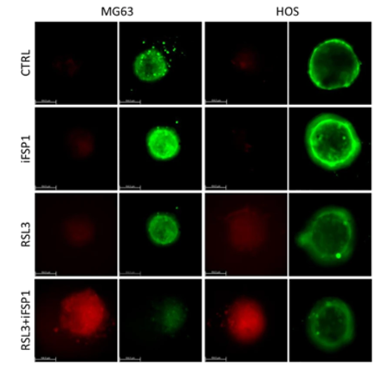- TEL:
- +81-3-5462-4831
- FAX:
- +81-3-5462-4835
※9:00-17:40 Mon.-Fri. (JST)



Elzbieta Panczyszyn, Valentina Saverio, Romina Monzani, Mara Gagliardi, Jelena Petrovic,
Jasmina Stojkovska, Licio Collavin and Marco Corazzari
Cell Death Discov. 10, 87 (2024). | https://doi.org/10.1038/s41420-024-01854-2
Copyright © Authors 2024
This article is licensed under a Creative Commons Attribution 4.0 International License (CC BY).
Human osteosarcoma (OS) is a relatively rare malignancy preferentially affecting long body bones, predominantly affecting adolescents and young adults. It is characterized by high metastasis rates, drug resistance, and frequent recurrence, leading to poor prognosis. Current treatment, involving surgical resection combined with multidrug chemotherapy, has achieved limited progress, with a 5-year survival rate of approximately 70%. Immune checkpoint inhibitors (ICIs), while effective in other cancers, have shown limited efficacy in OS. Meanwhile, ferroptosis, an iron-dependent form of programmed cell death, has emerged as a potential strategy to overcome drug resistance. However, the heterogeneity in ferroptosis sensitivity among tumor cells remains a major challenge.
|
This study aims to address the heterogeneous sensitivity of osteosarcoma (OS) cells to ferroptosis by investigating the role of ferroptosis suppressor protein 1 (FSP1). The study showed that OS cell lines displayed heterogeneous sensitivity to ferroptosis execution, correlating with the mesenchymal phenotype, which was consistently affected by the expression of FSP1 (HOS cells were more sensitive than MG63). |

|
Plate: PrimeSurface™ 96U plate
Cell: HOS or MG63 cell
Cell density: 3-5 x 103 cells/well
Meduim: DMEM (10% FBS)
Live/Dead Assays:
Day 4 spheroids were treated with RSL3 or iFSP1 or in combination for 4 h. Spheroids were incubated with the Calcein/PI staining mix for 30 minutes. Images were recorded by THUNDER 3D Cell Imager.
Images revealed that HOS cells are more sensitive than MG63, and that FSP1 inhibition consistently increases the susceptibility of both cell types to RSL3 treatment.
* RSL3: ferroptosis activator and iFSP1: FSP1 inhibitor
| Cat # | Product name | Well | Color | Bottom design | Well Vol | Package |
|---|---|---|---|---|---|---|
| MS-9096UZ | PrimeSurface™ 96U | 96 | Transparent | U bottom | 300 μL | Individual packaging 20 plates per case |
Remark